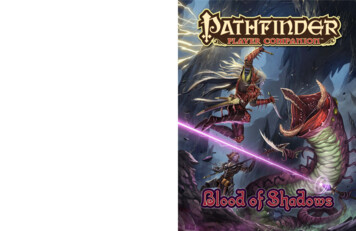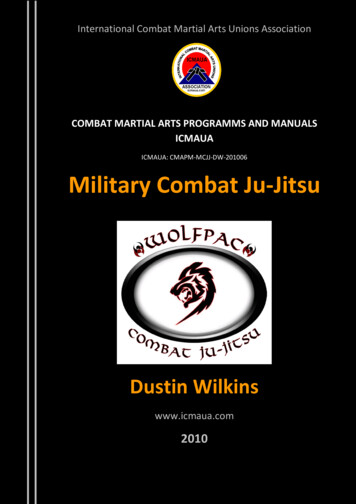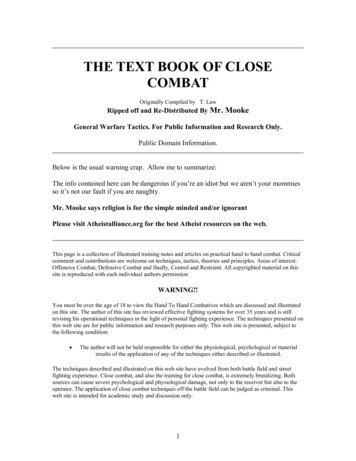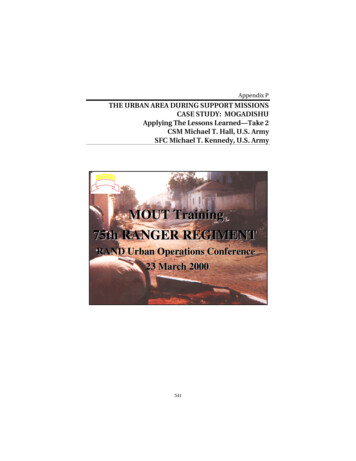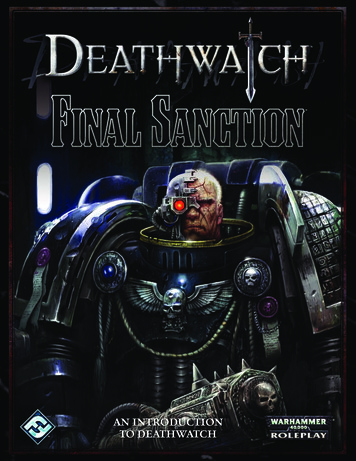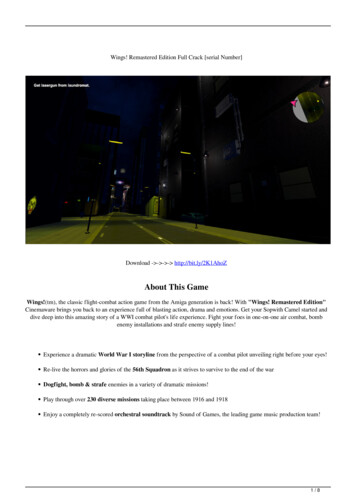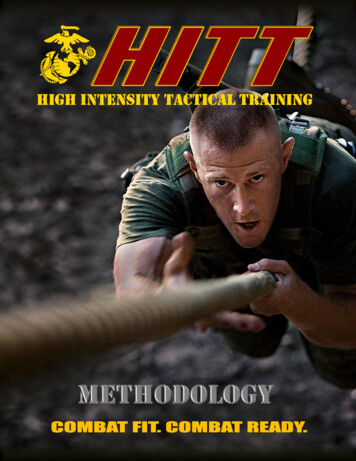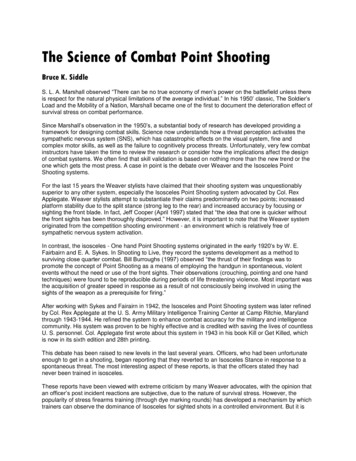
Transcription
The Science of Combat Point ShootingBruce K. SiddleS. L. A. Marshall observed “There can be no true economy of men‟s power on the battlefield unless thereis respect for the natural physical limitations of the average individual.” In his 1950‟ classic, The Soldier‟sLoad and the Mobility of a Nation, Marshall became one of the first to document the deterioration effect ofsurvival stress on combat performance.Since Marshall‟s observation in the 1950‟s, a substantial body of research has developed providing aframework for designing combat skills. Science now understands how a threat perception activates thesympathetic nervous system (SNS), which has catastrophic effects on the visual system, fine andcomplex motor skills, as well as the failure to cognitively process threats. Unfortunately, very few combatinstructors have taken the time to review the research or consider how the implications affect the designof combat systems. We often find that skill validation is based on nothing more than the new trend or theone which gets the most press. A case in point is the debate over Weaver and the Isosceles PointShooting systems.For the last 15 years the Weaver stylists have claimed that their shooting system was unquestionablysuperior to any other system, especially the Isosceles Point Shooting system advocated by Col. RexApplegate. Weaver stylists attempt to substantiate their claims predominantly on two points; increasedplatform stability due to the split stance (strong leg to the rear) and increased accuracy by focusing orsighting the front blade. In fact, Jeff Cooper (April 1997) stated that “the idea that one is quicker withoutthe front sights has been thoroughly disproved.” However, it is important to note that the Weaver systemoriginated from the competition shooting environment - an environment which is relatively free ofsympathetic nervous system activation.In contrast, the isosceles - One hand Point Shooting systems originated in the early 1920‟s by W. E.Fairbairn and E. A. Sykes. In Shooting to Live, they record the systems development as a method tosurviving close quarter combat. Bill Burroughs (1997) observed “the thrust of their findings was topromote the concept of Point Shooting as a means of employing the handgun in spontaneous, violentevents without the need or use of the front sights. Their observations (crouching, pointing and one handtechniques) were found to be reproducible during periods of life threatening violence. Most important wasthe acquisition of greater speed in response as a result of not consciously being involved in using thesights of the weapon as a prerequisite for firing.”After working with Sykes and Fairairn in 1942, the Isosceles and Point Shooting system was later refinedby Col. Rex Applegate at the U. S. Army Military Intelligence Training Center at Camp Ritchie, Marylandthrough 1943-1944. He refined the system to enhance combat accuracy for the military and intelligencecommunity. His system was proven to be highly effective and is credited with saving the lives of countlessU. S. personnel. Col. Applegate first wrote about this system in 1943 in his book Kill or Get Killed, whichis now in its sixth edition and 28th printing.This debate has been raised to new levels in the last several years. Officers, who had been unfortunateenough to get in a shooting, began reporting that they reverted to an Isosceles Stance in response to aspontaneous threat. The most interesting aspect of these reports, is that the officers stated they hadnever been trained in isosceles.These reports have been viewed with extreme criticism by many Weaver advocates, with the opinion thatan officer‟s post incident reactions are subjective, due to the nature of survival stress. However, thepopularity of stress firearms training (through dye marking rounds) has developed a mechanism by whichtrainers can observe the dominance of Isosceles for sighted shots in a controlled environment. But it is
important to note, that the isosceles dominance surfaces when an individual is confronted with aspontaneous and unexpected threat stimulus.This “startle response” is the single most important distinction between the two systems; for one systemwas conceived from combat stress environments, while the other was developed from competitionshooting. This distinction is the focal point of this article. The research will show that trained behavior isinhibited for economy in movement when survival reaction time is minimal.The purpose of this article is not to discredit the Weaver System, but an attempt to provide an objectivefoundation for designing combat firearms training. This article will examine combat stance selection fromtwo perspectives. First, we will examine how the sympathetic nervous system effects vision. Thisresearch will show that sympathetic nervous system (SNS) activation causes the pupils dilation, adecrease in blood flow to the periphery of the retina and the inability to use the dominant eye. The resultis the loss of near vision and the ability to focus on the front sight, the focusing on the threat and thecollapse of the peripheral vision, and forced binocular vision. This latter SNS controlled response causesthe head and body to square on the threat, a foundation of the Isosceles Stance.The second portion of this article will review new stress firearms studies. These studies were part of acontinuing effort to advance survival by observing how individuals respond to low level stress.Sympathetic Nervous SystemThe dominance of the SNS (and the startle response) is a function of the autonomic nervous system. Theautonomic nervous system controls visceral bodily functions and is divided into parasympathetic andsympathetic systems. The parasympathetic nervous system is in control in nonstress environments. Butwhen someone perceives that their life is in jeopardy, the sympathetic nervous system is automaticallyactivated.We now know that the sympathetic nervous system (SNS) is activated anytime the brain perceives athreat to survival, resulting in an immediate discharge of stress hormones. This “mass discharge” isdesigned to prepare the body for what has been recognized as the “flight or fight response” (also knownas the startle response). The response is characterized by increasing arterial pressure and blood flow tolarge muscle mass (resulting in enhanced gross motor skill and strength capabilities), vasoconstriction ofminor blood vessels at the end of the appendages, pupil dilation, cessation of the digestive process, andmuscle tremors.The activation of the SNS is automatic and virtually uncontrollable. It is a reflex triggered by theperception of a threat or fear. Once initiated, the SNS will dominate all voluntary and involuntary systemsuntil the perceived threat has been eliminated, performance deteriorates, or the parasympathetic nervoussystem activates to reestablish homeostasis.One of the most interesting aspects of SNS activation, centers around the debate of using the frontsights. Many have been led to believe that Applegate‟s Isosceles System is based on Point shootingsystem from the hip. This is far from the truth, for Applegate describes his system in the following manner,“point shooting, as I advocate, involves a stiff arm, locked elbow and wrist, plus a convulsive grip. Theweapon is raised to eye level like pointing a finger and instantaneously fired. Eyes are always on thetarget, not the sights. The gun is raised with a rigid arm (like a pump handle) and the arm pivots at theshoulder. The system is accurate at distances up to 15 yards” (Applegate, 1997).Col. Applegate further refines the debate by segmenting shooting principles into “sighted and aimedshooting. Sighted shooting is the visual process of focusing on the front sight and picking up the threat ina fuzzy peripheral picture. The aimed shooting principal is a technique where the shooter focuses on thethreat. The firing sequence of the aimed fire is completed by raising the handgun to eye level and firing asthe weapon intersects the visual line to the threat” (Applegate, 1998).
Applegate points out in combat that there isn‟t time to find the front sight and one will instinctively focuson the threat. This position is correct from the perspective of visual science. For example, perceptions aredelivered to the brain through the basic senses of sight, sound, touch, taste, and smell. Each systemprovides the brain with a constant source of information about the environment and physical activitythrough a complex neural receptor network. But when the brain perceives a threat, the brain will tune intothe system that can provide the most relevant information at that given second. This is referred to asperceptual narrowing.Perceptual narrowing in combat will result in the visual field becoming the dominant source of informationabout the threat. Keep in mind that the SNS is now activated and the eye goes through automaticchanges to enhance survival. One of these changes is the phenomenon of peripheral narrowing (alsoknown as tunnel vision)Research by Sports Optometrist Hal Breedlove; found that SNS excitement causes vasoconstriction tothe specific blood vessels of the retina. The retina is comprised of photoreceptors which innerate into theoptic nerve, which leads to the visual cortex. The photoreceptors are divided into rods and cones. Thecones provide color reception, resolution and acuity, and are densely populated in the center of the eye.The rods are concentrated on the periphery of the retina and are higher in number than the cones. Therods are responsible for light/dark sensitivity, as well as the detection of subtle and gross movements.Since there are more rods than cones, the optic nerve will receive more information about threats or theenvironment from the rods.Unfortunately, SNS excitement causes vasoconstriction to the blood vessels on the periphery of theretina. The reduced blood flow inhibits the photoreception of the rods, leading to a collapse of peripheralfield. Dr. Breedlove states that the visual field can be expected to narrow by 70%, as well as failing todetect subtle threat movements.Dr. Breedlove‟s research provides us with a scientific basis for tunnel vision and a defense for officers inthe courtroom. Just as important, this research provides part of the reason why officers will not be able tofocus on their front sights when the SNS is activated. This partially explains why officers state they couldonly focus on the threat and not the sights.The ability to focus on close objects is a function of the parasympathetic nervous system. This systemcontrols visual operations during non-stress conditions and facilitates pupil constriction, pupil dilation, thefocusing action of the lens through the ciliary muscle, and blood flow to the smaller capillaries leading tothe rods of the eye. However, the parasympathetic controls are inhibited when the SNS is activated.Cannon (1915) found that SNS excitement triggers pupil dilation, leading to the loss of near vision. TheSNS also disrupts the ability to focus, which is a function controlled by the tension on the ciliary muscle.This muscle maintains the convex shape of the lens, which is necessary for clarity and focus. But whenthe SNS is activated, the ciliary muscle relaxes and the contour of the lens changes from a convex to aflattened state. This results in a loss of depth perception and the ability to focus on close objects.Therefore, the ability to focus on the front sights of a handgun is not possible when the SNS is activated.Finally, the continuing debate over the importance of dominant eye also becomes a mute issue when theSNS is activated. This debate centers around the practice of using the dominant eye for precisionshooting. Optometrists refer to this as monocular vision, in contrast to using two eyes which is binocularvision. But again, the SNS inhibits monocular vision and forces an individual to square the head on thethreat and focus with binocular vision. Occurring simultaneously to forced binocular vision is the “lid lift”response of the eye lids. This function of the SNS serves as a method to increase the light into the retina.It is probably the basis for the century old adage of “waiting until you see the whites of their eyes”.Dr. Breedlove believes that binocular dominance is the primary reason why individuals in combat squareoff on their target in the Isosceles Stance.
His theory is consistent with kinesiology studies stating that the body will resort to the path of leastresistance and the most economical when under stress. This is also consistent with Applegate‟sinsistence on one handed Point Shooting, which was designed around by the body‟s natural response toa survival threat.Practical Stress Firearms ResearchSome instructors read physiology research and don‟t consider it valid until it has been applied withpractical research. However, there have been several studies whose findings are consistent withApplegate‟s theories of Point Shooting and the dominance of the SNS and vision. The following threestudies examined the effect of stress on stance selection and vision.Westmoreland (1989) was first to examine which sighted shooting stances were more suitable for theaffects of combat stress. His study examined ninety-eight shooting scenarios that were eitherspontaneous or non-spontaneous in nature. To induce stress, the scenarios consisted of dynamic trainingexercises where the officers confronted a role playing subject. The majority of the participants proclaimedto be Weaver practitioners. To enhance stress, the participants used ammunition that had been modifiedto shoot cotton projectiles. The result of Westmoreland‟s research is as follows:Spontaneous under 10 feet: 39 total scenarios96.7% Isosceles.(29 events)3.3% Weaver.( 1 event)62.1% One-handed stance (Isosceles).(18 events)23.1% Failed to respond.( 9 events)Spontaneous over 10 feet: 27 total scenarios92.6% Isosceles. (25 events)7.4% Weaver. (2 events)14.8% One-handed stance (Isosceles). (4 events)Non-Spontaneous under 10 feet: 27 total scenarios74.1% Isosceles. (20 events)25.9% Weaver. (7 events)Non-Spontaneous over 10 feet: 5 total scenarios60.0% Isosceles. (3 events)40.0% Weaver. (2 events)Study Totals56.1% Two-handed Isosceles stance .(55 events)12.2% One-handed Isosceles stance .(12 events)22.5% Two-handed Weaver stance.(22 events)9.2% Of the officers failed to respond.(9 events)Westmoreland identified three reasons why the officers In his study reverted to the squared off pointshooting stance. First, he classified the weaver as a fine motor skill which deteriorates at a relatively lowheart rate of 115 beats per minute. (For more information on motor skill classifications and survival stress,see Sharpening the Warrior’s Edge by Siddle, 1995.)Second, Westmoreland linked the “sudden injection of stress” as the critical consideration. And finely, hereferences “the inborn reflex to squarely face the attack.” Westmoreland accurately connects the inbornreflex to the fight or flight syndrome. He observed that when suddenly attacked in close quarters, it isnatural to “face our opponent squarely with our hands and arms extended out in front of us. This naturalstance is assumed by all animals that defend themselves on two legs. Add a handgun and you have anisosceles stance” (Westmoreland, 1988).
Westmoreland‟s study stood alone and was subjected to heavy debate until Bill Burroughs completed hisstudy in late 1997. Burroughs is an internationally respected firearms trainer who was previously aninstructor at the Smith & Wesson Academy and the former Assistant Director of the Sig Arms TrainingAcademy.The Burroughs Study set out to examine two issues; what stance does the average trained officer resortto when confronted with a simulated and spontaneous life threatening assault, and how does thisresponse compare to the officer‟s previously trained shooting stance.The study involved 124 officers participating in 155 life threatening scenarios. The officers and the roleplaying aggressors were issued weapons fitted with Simunition Technologies FX marking cartridges.Each officer was given a survey prior to the scenario requiring them to identify the shooting stance theywere trained in while in the academy and then later through in-service training.The primary survey reported 59% of the officers were Weaver trained, 21% of the officers were trained inIsosceles and 25% stated they used a Natural Stance. However, these percentages changed significantlywhen the officers participated in the study. Burroughs found that the percentages changed to 20%Weaver, 61% Isosceles and 3% Natural. Burroughs states, “By observation, those that remained in theWeaver had the opportunity to pre-select their stance before the scenario became critical. Most, however,were so shocked by the suddenness of the scenario that they demonstrated a pure survival response ofsquaring the body, extending and locking the arms, crouching the posture and viewing the threatbinocularly to fire. Of the 462 shots fired, (Simunition Technologies FX marking cartridges) 63% recordedhis and 43% were considered lethal.”The Westmoreland and Burroughs studies both focus on the link between spontaneous stress and thebody‟s natural response by squaring off on the target. In reviewing Westmoreland‟s research SportsPsychologist Robert Weinberg Ph.D. offered, “One principle which seems appropriate is the individualsusually return to their preferred or instinctual mode of behavior (in this case a movement pattern)especially under stress. When put into a stressful situation (in a police officers‟ job, sometimes a lifethreatening one) it is instinctual to face your opposition rather than turn to the side. This is a stronginstinct since its part of the fight or flight response to anger.”Both studies found that when an officer is confronted with a spontaneous threat or startled, the body willuncontrollably square on the target an assume a point shoulder position. The most interesting aspect ofthis study is that it is consistent with the Fairbairn/Sykes and Applegate research, which was based onthe observation of men‟s natural positioning in actual combat.The study also highlights the fact that officers will not use their front sights if the SNS is activated. Manybelieve that training to use their front sights will be ingrained as a muscle memory, which will dominate anofficer‟s action during combat. Applegate points out that in combat it is natural to focus on the threat andthe ability to “focus” on the front sights is not combat based. And as we discussed in this article, sciencesides with Applegate.A 1997 study conducted by Doug Ashton and Jay Quinlin of the Peel Regional Police, Canada, examinedthis very issue. Ashton and Quinlin placed 100 recruits in dynamic training scenarios using Simunitionscartridges. The scenarios placed the recruits in a situation where they were confronted with a knifeyielding subject who spontaneously attacks the officers. Each student was given web gear complete witha simunitions converted firearm. The students were not allowed to inspect the weapon before thescenario.Each scenario was videotaped for record keeping and documenting the students‟ response. After thescenario, the students were given a verbal post incident report asking them if they had seen or used theirfront sights, and did they hear the verbal response of the aggressor before the attack. This report wasthen cross-referenced with the video tape for accuracy.
Ashton and Quinlin found that 98 out of 100 recruits reported they didn‟t see their sights. Most stated theydidn‟t have time. This is an interesting observation and can be validated by a fourth study conducted bySgt. Tom Hontz of the Scottsdale, Arizona Police Department.Hontz‟s study set out to explore the average response time needed to draw a weapon from differentstarting points. His comprehensive study examined the time needed to draw a firearm from a holsteredposition, a front draw from the pants, a rear draw from behind the back and a simple raise and fireexercise.Of particular interest, is the finding of the average time needed to raise and fire a handgun. With 20officers participating in a pure movement time study, Hontz found the average time needed to raise andfire a handgun is 0.59 of a second.Hontz then contrasted the movement time findings with the average time an officer would need to draw aweapon from a holster and fire a single round. For this section of the study, he used 76 officers and foundthe average response time was 1.9 of a second. The implications of this study are unparalleled whendefending officers in court. The research shows that the average assailant will have at least an advantageof 1.31 seconds over the officer.Once again, we find the research is consistent with the effects of the SNS and vision. We have alreadydiscovered that SNS activation dilates the pupils, which inhibits the ability to focus on the front sights. Butwe must also recognize that when the SNS is not activated, the visual system takes about one second toswitch from far/distant vision to the near vision (Guyton‟s Medical Textbook). So even if the SNS isn‟tactivated, there still will not be sufficient time to gain “focused” sight alignment and return fire. (Here isanother example of how the human body will adapt when survival is threatened and time is minimal.)The Peel study did surface another side of survival stress. Two recruits insisted they had seen their frontsights. However, the researchers were quick to not that this wasn‟t possible, since they issued a weaponthat had the front sights removed. Ashton speculates the two were trying to reflect they had followed thedepartment„s firearms training program, which encourages the use of the sights with all weapondischarges. (All of the students but one experienced total auditory exclusion.)AccuracyOne of the more fascinating findings of the Burroughs Study is the increase percentage of shooting andhitting a live target. He found that 63% of the 462 shots fired hit their target, while 43% would have beenconsidered lethal. This data would suggest that there is a direct relationship between increased accuracyand the simplicity of the Isosceles Point Shooting systems.This hypothesis was tested by Steve Barron and Clyde Beasley of Hocking College in Ohio. Barron andBeasley are the firearms manages for the regional police academy training and had noticed thediscrepancy between static range activities and dynamic role playing (dynamic role playing wasconducted with Simunition cartridges). Barron notes “We noticed that stance and technique, more oftenthan not, would suffer a total breakdown in any of the shooting exercises that applied some stress on thetrainee. This phenomenon occurred with such frequency that we knew something was very wrong. Thisreinforced our earlier observations. It seemed as though our trainees would display an excellentcommand of the new technique (Weaver) on the static firing range; but when the stress factor was raisedand they were put in a more realistic training environment, technique and stance deteriorateddramatically.”Barron goes on to note that his staff followed up with remedial training and noticed improvement on thestatic firing line. However, “their reinforced basic skills crashed and burned” when the students wereexposed to the stress of dynamic training.
After a review of the deteriorating effects of stress on Weaver, Barron and Beasley decided to find asystem which was more compatible to combat stress. This investigation led them to Col. Applegate andafter attending his instructor school, they implemented the Apple Point Shooting System.Barron and Beasley have now trained more than 500 students in the Applegate System of Point Shooting.They reported to the author that scores have increased to 95% and higher, from 90-95% on the staticfiring line. He states “this system is equal or superior in accuracy”. But more importantly, the students aremaintaining the simple Point Shooting system when they are participating in the stress induced dynamictraining exercises. Barron attributes this improvement to the simplicity of the Applegate System.The study of skill complexity can be traced back to the Civil War. As research methods and technologieshave advanced, scientists found that physical or mental stress reacted differently on different types ofmotor skills. Researchers began to classify motor skill on a progressive continuum from fine to gross,according to muscle size, task, complexity, task effort/fatigue, and how levels of stress affect performanceby monitoring escalating heart rates (Cratty,1973). Scientists continued to refine their research and foundthat SNS activation triggered the deterioration of fine and complex motor skills.Today, motor skills are divided into the following three basic classifications.Gross motor skills; are skill which involve the action of large muscle or major muscle groups. An exampleof a survival gross motor skill would be simple actions such as straight punch, a forward baton strike orthe Isosceles shooting stance. Generally, gross motor skills are simple strength skills or skills involvingsimple symmetrical movements.Fine motor skills; are skills which require hand/eye coordination and hand dexterity. In the survival skillcategory, a fine motor skill would include any action that requires precision hand eye coordination, suchas precision shooting a firearm accurately.Complex motor skills; are skills which involve a series of muscle groups in a series of movementsrequiring hand/eye coordination, precision, tracking and timing. Survival skills that are complex wouldinclude shooting stances that have muscle groups working in different or asymmetrical movements(Weaver), or a takedown that has more than multiple independent components.By using escalating heart rates as a medium to chart performance, scientists found that high or evenmoderate levels of stress interfere with fine muscular control and decision-making. In contrast, motorskills dominated by large muscle groups, which have minimal fine motor control and very little decisionmaking or cognitive complexity, are not affected by high levels of stress. Studies have also found that finemotor skills deteriorate at 115 BPM; complex motor skills deteriorate at 145 BPM, while gross motor skillswere performed optimally at higher levels of stress.Weaver falls into the complex motor skill category and will generally degrade once the heart rate peaks to145 beats per minute. This is important, since a deadly force threat will drive heart rate well above 200beats per minute. (This research is consistent with SNS vasoconstriction to the hand and fingers, whichdeteriorates the dexterity needed for precision shooting skills, combat reloading or the operation of avehicle.)SummaryIn an attempt to summarize this research paper, consider the following;1. The SNS will be automatically and uncontrollably activated when an officer or soldier is confronted by aspontaneous or unexpected threat stimulus. However, the SNS may also be activated when an individualis not confident in their ability to manage the threat or apprehensive about the pending situation.2. Once activated, the SNS will inhibit vital survival functions involving near vision, and fine and complexmotor skills. Shooting skills which require precise hand/eye coordination and asymmetrical stances are
not stress compatible and should be avoided for spontaneous combat responses. However, when SNS isnot activated, personnel will be able to focus on their front sights and use the more complex Weaversystem. (The author has been able to refine this position in more detail. He has found that the SNS rarelyactivate when the officer soldier has time, distance or cover. All three are perceptions of control, andsubsequently deters SNS activation.)3. Despite what many have been told, the body does in fact have “instinctive” responses which appear tobe preprogrammed into our neural networks. This includes squaring off on the threat and bringing botharms out in front in a point should position. Research in motor learning sciences and kinesiology supportsthe notion that economy in movement is in direct proportion to skill simplicity.The selection of a combat shooting stance should not be reduced to which system offers the bestbiomechanical support or the best sight picture. What is important, however, is whether we teach skillswhich are the most compatible to survival stress.It has often said that combat training will ultimately evolve towards simplicity and economy in movement.This axiom speaks volumes once you understand the dominance of the SNS on combat performance.Understanding the implications of the SNS in combat is fundamental to selecting a combat firearmssystem. The research clearly substantiates Point Shooting principles and the system advocated by Col.Applegate.About the AuthorBruce Siddle is a 20 year law enforcement veteran, the Executive Director of PPCT ManagementSystems, one of the largest research based use of force training organizations in the world.Mr. Siddle has been an active consultant for hundreds of criminal justice agencies, including specialoperations/warfare units for the U.S. Dept. of Navy, U.S. Dept. of Army, U.S. Air Force, the FBI‟s hostageRescue Unit, the U. S. Secret Service, the 22nd SAS, and the Queen of England„s personal protectionunit (Royal Protection Group). Mr. Siddle is also the author of Sharpening the Warrior‟s Edge, the first textto provide a scientific explanation into survival str
sighting the front blade. In fact, Jeff Cooper (April 1997) stated that "the idea that one is quicker without the front sights has been thoroughly disproved." However, it is important to note that the Weaver system originated from the competition shooting environment - an environment which is relatively free of


